Projects of infantry fighting vehicles in NATO countries
US Marines land from their BMN M2A3 Bradley
Armed with guns BMP, created for motorized combat, are an integral part of the modern ground forces. Consider the latest developments in this area, conducted in the armies of NATO.
During a ceremony held on June 24, 2015 at the Unterlus test site, PSM Projekt System & Management officially handed over the first production Puma vehicle to the German army. For the army, this event became significant, since the third-generation BMP was adopted.
In the German army, the Puma infantry fighting vehicle will replace the Marder 1 tracked vehicle manufactured by Rheinmetall Landsysteme, which entered service in 1971. With the adoption of the tracked Schutzenpanzer SPz 12-3 in 1958, Germany became the first NATO country to develop and deploy a typical infantry fighting vehicle. The German army was not entirely convinced of the correctness of the then American idea of an armored personnel carrier as a "combat taxi" that would land its infantry squad and hide in cover until the need to move the squad again arose.
Armed with a 20mm cannon, the SPz 12-3 BMP was perceived as a vehicle that could be used by an infantry squad rather as a regular weapon system than just a vehicle. The German army made a compromise here, as it needed heavier weapons and additional armor to participate in direct combat clashes. As a result, the BMP SPz 12-3 could take a squad of only five infantrymen. This car was also tormented by mechanical problems and, in the end, the German Ministry of Defense in 1960 issued a contract for the development of its successor.
Requirements for the future machine designation Marder 1 included: 20-mm cannon, the ability to carry 12 people (crew - commander, gunner and driver, and 9 infantry infantry unit), the ability for troops to fire from inside the machine. And again the German army was forced to compromise and accept that only six infantry could be accommodated in the aft troop compartment.
BMP Marder 1
Initially, the car had four loopholes, two on each side of the troop compartment; this allowed the landing party in the car to fire from personal weapons. But, starting from 1989, on the upgraded versions of Marder 1A3, these embrasures began to be closed with additional armor screens.
The Marder 1 BMP was never used in high-intensity combat operations, for which it was actually created, although it was deployed by the German contingent in the former Yugoslavia in the 90s and in Afghanistan in the 2000s, where improvised explosive devices became the main threat to this machine. (IED).
Marder 1A5
The army upgraded 74 Marder 1A3 vehicles to A5 standard in 2003-2004, installing additional armor to protect against mines and IEDs and reconfiguring the armored space to reduce injuries and shell shock from the explosion and shock wave. Some vehicles were upgraded to the A2010A2011 standard in 5-1 by installing an IED silencer, an air conditioning system and multispectral camouflage. Germany sold from the presence of its army 280 BMP Marder 1 to Chile and 50 vehicles to Indonesia; no doubt there will be other buyers for these machines.
The German army officially received the first 350 BMP Puma 24 June 2015
big cats
PSM (a joint venture between Krauss-Maffei Wegmann and Rheinmetall) was awarded the contract to develop the Puma tracked vehicle in 2004. The initial need was determined at 405 vehicles, but in June 2012 Berlin reduced their number to 350 units, which was the result of a reduction in the size of the army; The last batch is scheduled to be delivered in 2020. The value of the contract today is 4,3 billion euros.
According to representatives of the PSM company, the main thing for the army was to develop an infantry fighting vehicle "with levels of protection that vehicles of this class do not have." Other key requirements included strategic and tactical mobility, firepower, situational awareness, network-centric warfare and command within an international coalition, combat readiness in extreme weather conditions with a minimum material and technical base, and, finally, interfaces with a friend-foe identification system. , the German information and control network FuInfoSyS C4I, with IdZ combat equipment and active protection systems.
The Puma BMP, like the Marder BMP, accommodates a crew of three plus six paratroopers. The installation of a remote-controlled tower allows all crew members to be placed in the vehicle body. The turret is armed with a 30 mm Mauser MK 30-2/ABM (Air Burst Munition) selective feed cannon and a coaxial 5,56 mm MG4 H&K machine gun (Heckler & Koch). The gun can fire armor-piercing sub-caliber projectiles and air-blast ammunition with a remote fuse.
The German army plans to replace the MG4 with a new 7,62mm HK121 H&K machine gun, which allows the shooter to select a rate of fire of 600, 700 or 800 rounds per minute. On the left side of the tower are two launchers (PU) ATGM EuroSpike-LR.
The Puma infantry fighting vehicle weighs 31,45 tons in the basic Protection Class A configuration, which allows the vehicle to be transferred by the Airbus A400M transport aircraft, which is currently entering service with the German army. The Protection Class C kit adds 9 tons to the weight of the vehicle and consists of additional turret armor, armor plates on the roof and side panels that cover most of the sides and work like caterpillar screens. The additional protection kit is a combination of composite armor and dynamic protection units.
In accordance with the German military doctrine, Panzergrenadier motorized infantry battalions, which will receive the Puma infantry fighting vehicle, together with the battalions tanks Leopard 2s are recruited into armored divisions and undergo joint training at the tank training center in Münster. Three infantry companies of the battalion will receive 14 Puma vehicles each, two more vehicles will be given to the battalion headquarters, therefore, each battalion will be armed with 44 infantry fighting vehicles. The companies will receive their vehicles at the training center, undergo a three-month training there and then return to their positions with new Puma vehicles. The first of eight such battalions, Panzergrenadierbataillon 33, should reach full combat readiness in 2016.
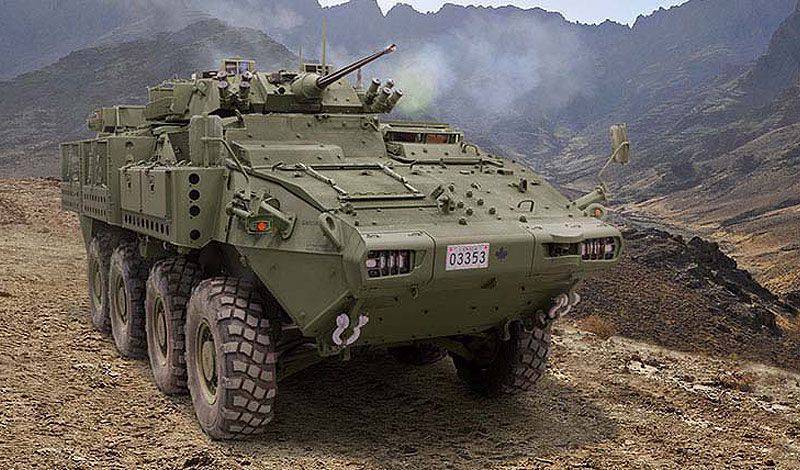
The LAV III Canadian Army manufactured by GDLS Canada is one of several BMPs based on the Piranha chassis.
Popular in Europe
The most widespread tracked infantry fighting vehicle in Europe is the CV90 manufactured by BAE Systems Hagglunds, which will soon be in service with seven countries. Its development began in 1984 in order to meet the need of the Swedish army for an infantry fighting vehicle that combines mobility, protection and firepower with a modular design in order to use this vehicle for other tasks, such as air defense. Deliveries of the first of 509 vehicles for Sweden began in 1993. Nearly 700 IFVs were sold, including to Denmark (45), Finland (102), the Netherlands (193), Norway (146) and Switzerland (186). Most recently, in December 2014, Estonia bought 44 CV9035NL infantry fighting vehicles from the presence of the Dutch army. Danish, Dutch, Norwegian and Swedish vehicles have been deployed in the fighting in Afghanistan.
Swedish CV9040 infantry fighting vehicles are armed with a 40 mm Bofors cannon, but all foreign customers chose 30 or 35 mm guns. The latest standard CV9035 Mk III significantly increased the combat capabilities of the vehicle. A 35-mm Orbital ATK Bushmaster III cannon, an independent commander's sight with search and strike capabilities, third-generation thermal imagers for the shooter and commander were installed, high-level protection was integrated, including protection against mines and cluster munitions, a combat control system, protection systems and a tire were installed. high-speed data transfer, and increased payload capacity for future upgrades.
In June 2012, Norway awarded BAE Systems a $750 million contract to upgrade 103 CV90s and build 41 new ones. Ultimately, the fleet will consist of: 74 infantry fighting vehicles; 21 reconnaissance vehicles with an optoelectronic observation station on the mast; 15 control points; 16 engineering vehicles; 16 multi-purpose vehicles that can be configured for various tasks, such as a mortar system or logistics, and two training vehicles.
Dutch BMP CV90
Norwegian upgrades include higher-level armor protection, digital electronic architecture, improved situational awareness system, the installation of a Kongsberg remotely controlled weapon station (RCWS) with a 12,7-mm M2HB machine gun on the roof on all variants with 30-mm cannons. This DBM can be used in search-and-attack mode and as an aiming system for a 30mm cannon, and it can also fire from the troop compartment. Two pre-production vehicles were delivered in February 2014 for extended testing, and the first production vehicle was handed over to the troops in February 2015.
The Swedish organization of defense procurement is also engaged in an extensive modernization of the entire fleet of Swedish CV90 infantry fighting vehicles, which will consist in installing a new battle management system, which will extend the life of the vehicles to 2030 of the year.
Finnish fighter
The project of the modular armored vehicle AMV (Armored Modular Vehicle) 8x8 by the Finnish company Patria has become popular, this vehicle is often chosen as an infantry fighting vehicle. In April 2013, the Polish Ministry of Defense signed a contract that provides for the joint production of 570 AMV 8x8 vehicles in Poland; there these machines received the designation Rosomak. This number included 313 infantry fighting vehicles equipped with an OTO Melara HITFIST-30P turret armed with a 30 mm MK44 Bushmaster II cannon. Rosomak machines have been deployed in Afghanistan since 2007. In October 2013, Poland ordered another 307 vehicles worth $544 million with deliveries scheduled through 2019, and issued separate contracts to upgrade 99 existing vehicles.
These contracts included 122 infantry fighting vehicles equipped with an uninhabited turret developed by the Polish companies HSW and WB Electronics and armed with a 30-mm cannon and two Rafael Spike ATGM launchers. According to the schedule, the development of this tower should be completed this year. Two battalions of the mechanized brigade, which are planned to be given to the NATO High Readiness Joint Task Force, will be the first units to receive new BMPs.
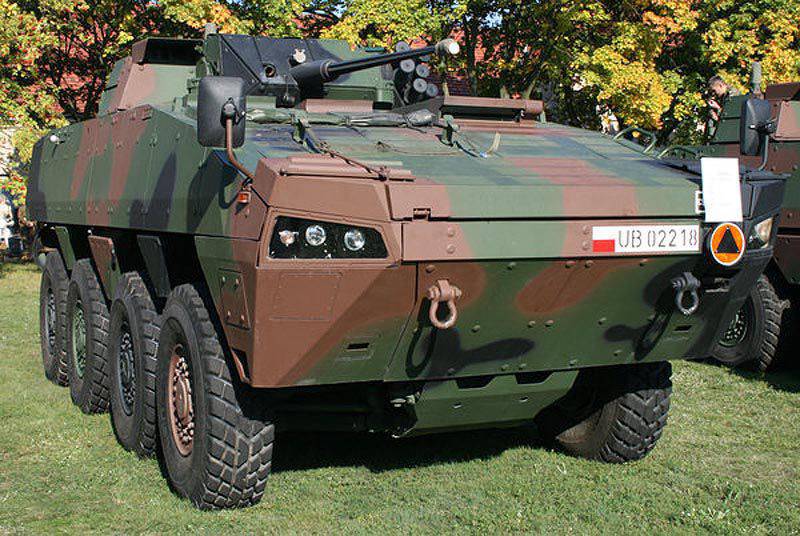
BMP AMV-Rosomak
The terms of the Polish contract with Patria make it possible to offer the Rosomak machine for export to other countries. In July 2015, Slovakia announced the purchase of 31 Rosomak 8x8 chassis worth $31 million, which will be equipped with TURRA 30 uninhabited turrets developed by local companies EVPU and DMD Group. In this configuration, the machines will receive the designation Scipio. Slovakia is expected to buy 66 vehicles to equip two battalions.
A demonstrator under the designation Rosomak-Scipio 8x8 was shown at the IDET defense exhibition, held in May 2015 in the Czech Republic. The TURRA 30 turret can accept Russian weapons, including a 30mm 2A42 cannon, a 7,62mm PKT machine gun and two 9K111 Fagot or 9K113 Konkurs ATGM launchers. At the IDET exhibition, the TURRA 30 turret was shown with a Western weapon system consisting of a MK44 Mod 1 Bushmaster II cannon and a 12,7 mm M2HB machine gun.
The South African Army has also chosen the AMV to meet its needs for infantry fighting vehicles. Denel Land Systems received a contract in September 2014 worth approximately $ 900 million for the supply of 238 Badger vehicles in four variants, including an infantry fighting vehicle equipped with a Denel LCT30 twin turret with a GI-30 30-mm cannon with selective power from the same company and twin 7,62, 18 mm machine gun. In addition to the crew of three, eight paratroopers are placed on energy-absorbing seats in the aft compartment of this infantry fighting vehicle. The first XNUMX Badger cases are supplied by Patria, while the rest will be manufactured at a local factory.
Pumped BMP BRADLEY
The BAE Systems Bradley Fighting Vehicle has been at the forefront of virtually all U.S. Army operations since it entered service in 1983. The tracked IFV in the M2 variant is in service with motorized infantry battalions, and the M3 variant is used by reconnaissance units as part of the ABCT armored brigade groups. The M2 variant is equipped with a two-man turret armed with a 25 mm M242 Bushmaster cannon, a coaxial 7,62 mm M240C machine gun and two TOW ATGM mounts. In addition to the commander, gunner and driver, seven people are accommodated in the aft troop compartment.
The Bradley has received numerous upgrades over its lifetime. The latest version of the A3 has digital electronics to enhance information awareness and enable network connectivity and data exchange within the ABCT. The Bradley A2 ODS-SA variant includes improvements such as anti-fragmentation liner and attachment points for hinged armor screens introduced after Operation Desert Storm in 1990-1991, plus the same capabilities as the A3 variant, including a laser rangefinder, GPS and navigation system.
Bradley A2 ODS-SA Option
Two U.S. Army initiatives to replace the Bradley in recent years have come to nothing. The first project was the Future Combat Systems (FCS) program, according to which the Manned Ground Vehicle (MGV) family of ground combat vehicles was to be deployed, including the XM1206 armored personnel carrier, which was supposed to be armed with an MK44 cannon and 7,62 mm machine gun, carry two crew members and nine paratroopers. Budget cuts in 2009 led to the cancellation of the FCS program, without answering the question - "could the MGV provide sufficient protection against IEDs?"
Later, a project was launched on the ground combat vehicle Ground Combat Vehicle (GCV), according to which, starting from 2, it was supposed to deploy 2018 infantry fighting vehicles to replace the M1874 Bradley. The goal of this program was to develop an infantry fighting vehicle with better lethality and ballistic protection than the Bradley, better protection against mines and IEDs than the vehicles of the MRAP category and off-road patency comparable to the patency of the M1 Abrams tank. For this project, a key requirement was put forward to accommodate nine people in the troop compartment.
The army in 2011 issued a two-year technology development contract to BAE Systems and General Dynamics Land Systems (GDLS). Facing cuts that would not allow the army to finance immediately the development of a new GCV machine worth 29 billions of dollars and proposals for constructive changes for existing machines, the army decided to abandon the first project in February 2014 of the year.
The Army is funding a phased modernization of the Bradley BMP in accordance with several proposals for structural changes, the first of which is to restore the volume, mass and power and install a new suspension system and lightweight tracks. The second proposal is a more powerful engine, new transmission and new electrical equipment.
In May 2015, the army awarded contracts to BAE Systems ($28,87 million) and GDLS ($28,27 million) to develop a technology concept for a promising combat vehicle until November 2016. Undersecretary of the Army Colonel Michael Williamson's report to the Senate Armed Services Committee noted that "The Army is investing in science and technology to refine concepts and technology that will enable combat vehicle requirements and reduce the risk of technology integration. This work will support a promising infantry fighting vehicle and at the same time maximize the ability to translate these technologies into current and future combat vehicles.
GDELS company developments
The ASCOD infantry fighting vehicle (Austrian-Spanish Cooperative Development - Austrian-Spanish joint development) was developed to meet the common needs of the armies of the two countries in a medium-weight tracked vehicle that would combine good survivability, mobility, reliability and firepower. Steyr-Daimler-Puch (now part of General Dynamics European Land Systems (GDELS)) manufactured 112 Ulan vehicles for the Austrian army. In turn, in 1992, Spain issued a contract to Santa Barbara Sistemas (now also part of GDELS) for the manufacture of the first batch of 123 Pizzaro infantry fighting vehicles and 21 control points. The BMP variant has a double turret with a 30 mm Mauser MK30-2 cannon and a coaxial 7,62 mm machine gun, eight paratroopers are placed in the vehicle.
In September 2003, GDELS received a contract to supply improved Pizarro vehicles, including 106 infantry fighting vehicles, as well as new surveillance, evacuation and engineering options. The last Phase 2 vehicles are expected to be delivered in 2016. The upgrades include an improved hull design, full digitization, a new power block, modern sensors, and improved stabilization and automatic target tracking.
In the IFV configuration, the Piranha 8x8 vehicles manufactured by GDELS-Mowag and the related LAV model manufactured by GDLS Canada were purchased by many countries. The newest generation Piranha 5 (the first in the 30 ton weight category) has significantly increased survivability, mobility and firepower compared to previous generations. Several towers were installed on this machine. As part of the Canadian melee vehicle project, GDLS installed a Rheinmetall Lance modular turret armed with a 30mm MK30-2/ABM. At IDEX in February 2015, GDELS showed a Desert Piranha variant optimized for the desert and fitted with a two-man 30/40mm Cockerill 3030/40 turret.
Modernization of the British WARRIOR BMP
The goal of the Warrior Capability Sustainment Program (Warrior Capability Sustainment Program) is to extend the life of the Warrior tracked infantry fighting vehicle in the British Army until 2040. The next step forward was taken in July when the Department of Defense awarded a $236 million contract to CTA International for 515 Cased Telescoped Armament System (CTAS) 40mm cannons for the WCSP program and the new Scout SV reconnaissance vehicle. Since 1987, the army has received 789 Warrior vehicles in several variants; relatively recently they were intensively exploited in Iraq and Afghanistan. The BMP accommodates three crew members and seven paratroopers in the aft compartment, the vehicle is armed with an unstabilized, clip-loading 30-mm L21 RARDEN cannon.
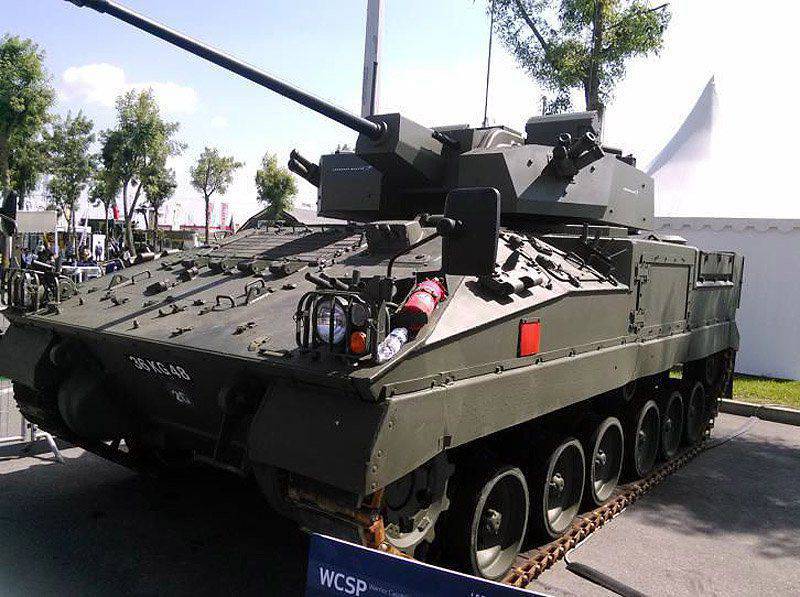
The Warrior infantry combat vehicle upgraded as part of the WCSP program
In October 2011, Lockheed Martin UK received a £225 million contract for the WCSP demonstration phase, but the Department of Defense has yet to issue a contract to upgrade 380 vehicles to recruit six mechanized infantry battalions. The company abandoned its original plan to upgrade the existing turret in favor of developing new turrets armed with CTAS. The upgraded Warrior BMP is scheduled to enter service in early 2020.
Lockheed Martin and BAE Systems offer Kuwait to upgrade its Desert Warrior 254 machines, which are equipped with a twin tower with a Bushmaster 25 gun.
Italian lines
The Freccia 8x8 infantry fighting vehicle was developed by the CIO consortium in order to meet the needs of the Italian army for an infantry fighting vehicle that could enter service with motorized infantry units. In turn, the armored brigades are armed with tracked infantry fighting vehicles Dardo. In 2006, the Italian army ordered 172 Freccia infantry fighting vehicles, 36 anti-tank installations, 20 command and 21 mortar systems. Deliveries that began in 2009 should be completed in 2015.
BMP Freccia
On the Freccia BMP, the HITFIST Plus turret was installed, armed with a selective-powered Xeri X-gun with Oerlikon KBA gun with selective power and an 25-mm machine gun paired with it. In 7,62, Rome approved the financing of the second batch of 2014 Freccia vehicles, including the 381 BMP, which are expected to receive upgraded undercarriage and power unit developed by the CIO for the Centauro 261 artillery mounts.
french fashion
Nexter will soon complete production of 550 VBCI 8x8 (Vеhicule blindе de combat d'infanterie) infantry fighting vehicles and 150 command variants intended for the French army. A similar 8x8 configuration was chosen in order to get a vehicle with good mobility and maneuverability, which could operate in the same battle formations as the Leclerc tank, but which would be cheaper compared to tracked infantry fighting vehicles, such as the AMX-10P (VBCI came to replace it ). The VBCI infantry fighting vehicle is equipped with a single-man Dragar turret with a 25-mm cannon, the vehicle accommodates a crew consisting of a driver and a gunner, and an infantry squad of nine people. A modular set of sheets of titanium-steel alloy is attached to the body of armored aluminum. At the beginning of this year, the army received the first 95 VBCI vehicles with enhanced armor and additional protection against mines and IEDs. But such an increase in protection did not pass without a trace, this upgrade kit increased the weight of the vehicle from 29 to 32 tons. The French BMP has completed combat service in Afghanistan, Lebanon and Mali. At IDEX 2015, Nexter showed a VBCI vehicle with a new two-man T40 turret armed with a 40mm CTAS cannon and a coaxial 7,62mm machine gun, which has ATGM mounts on each side.
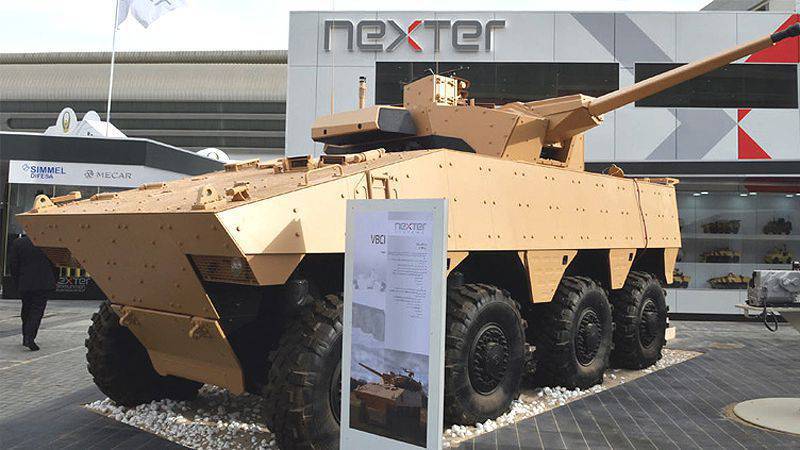
Nexter installed its new twin-turret T40, equipped with CTAS 40-mm gun, on the VBCI BMP
Materials used:
www.janes.com
www.baesystems.com
www.kmweg.de
www.rheinmetall.com
www.patria.fi
www.nexter-group.fr
www.lockheedmartin.co.uk
www.iveco-otomelara.com
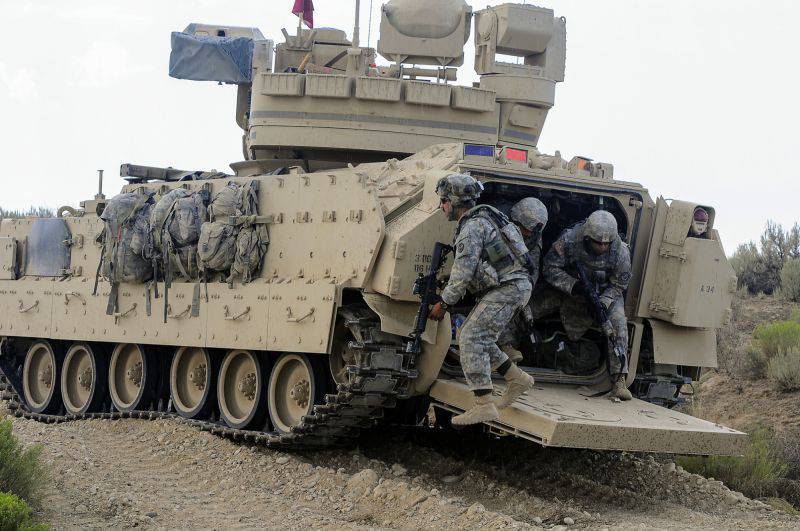
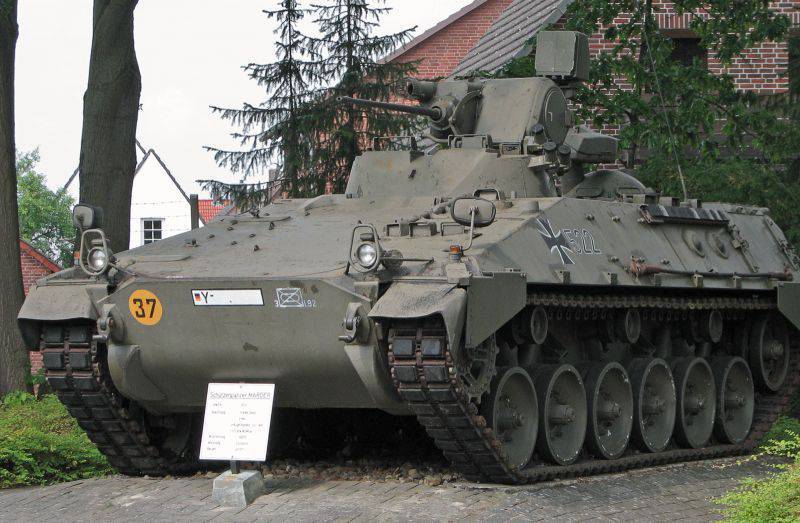
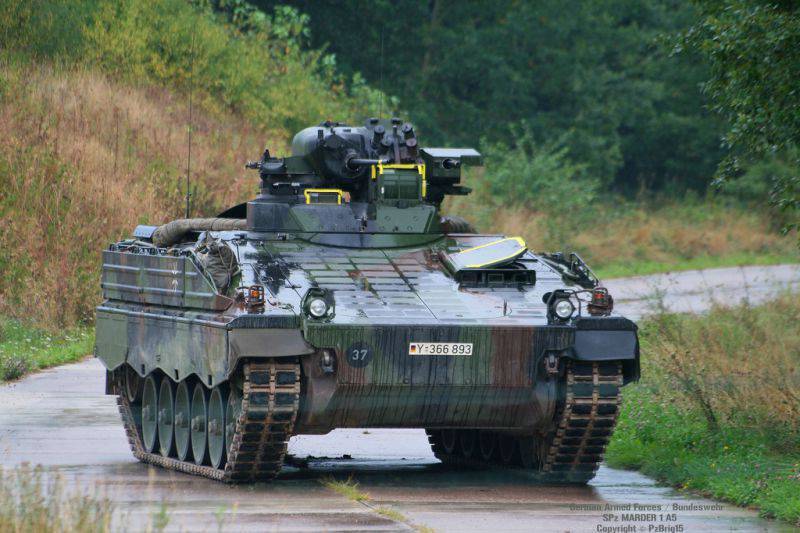
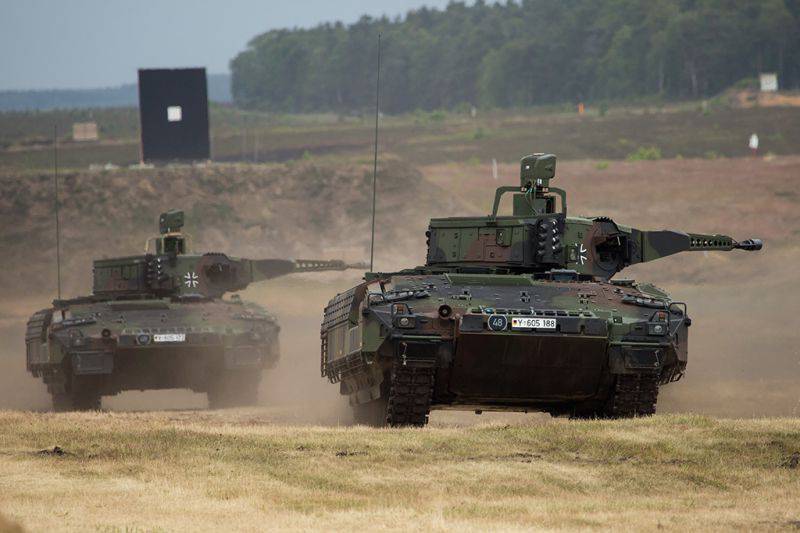
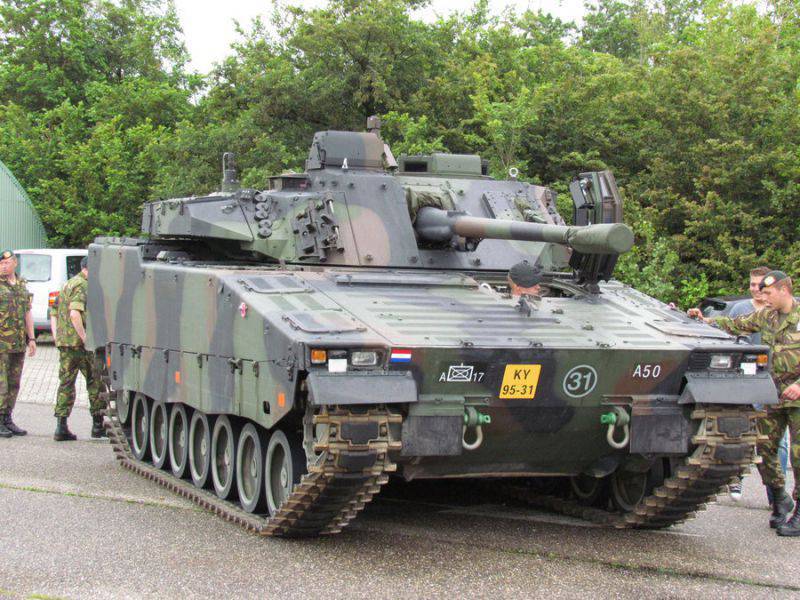
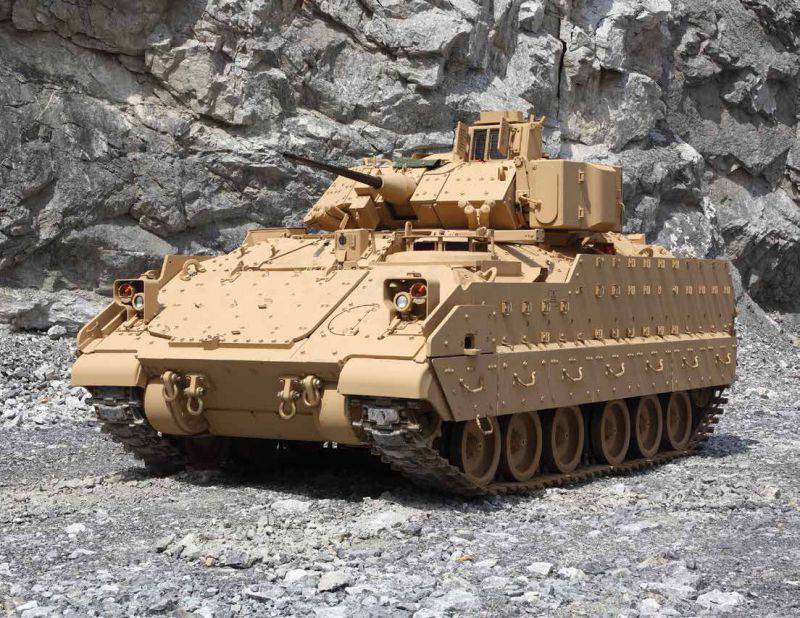
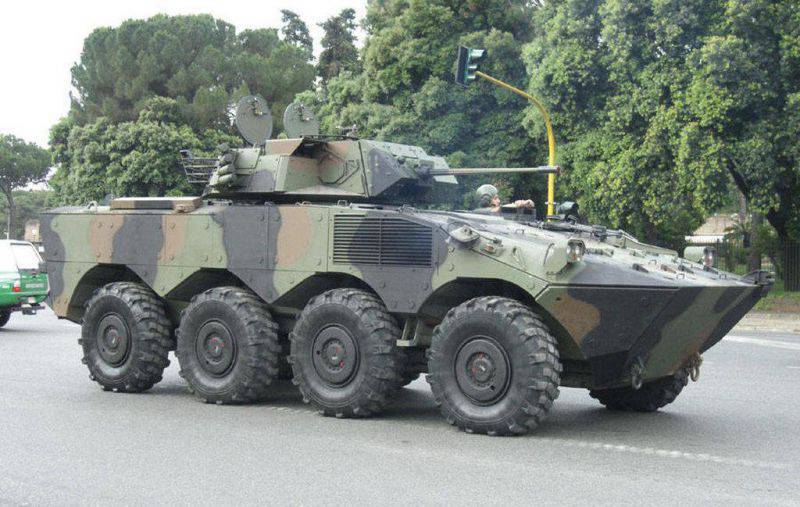
Information